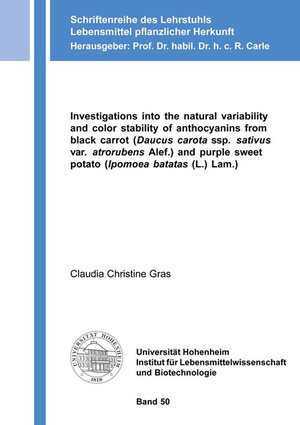
×
![Buchcover ISBN 9783844059410]()
Investigations into the natural variability and color stability of anthocyanins from black carrot (Daucus carota ssp. sativus var. atrorubens Alef.) and purple sweet potato (Ipomoea batatas (L.) Lam.)
von Claudia Christine GrasAmong all intrinsic sensory characteristics of food products, color is considered to be of paramount importance for the expectations of consumers regarding their freshness, taste, and flavor. However, the genuine color of foods or ingredients often fades during processing and storage, resulting in a strong technological need for its stabilization or restoration by synthetic or natural pigments. Therefore, the present doctoral thesis aimed at evaluating stabilization strategies for mono- and di-acylated anthocyanins from black carrot and purple sweet potato, respectively. Additionally, studies into the qualitative and quantitative variability of anthocyanins in these deeply purple colored vegetables were a further goal of this work in order to identify appropriate raw materials for the production of coloring foodstuff. In Chapter 1 of this thesis, an exhaustive, timesaving, and cost-effective procedure comprising a modern ultrasound-assisted extraction and either a rapid UHPLC-PDA or a conventional HPLC-PDA method for the identification and quantitation of anthocyanins were developed and validated. The developed methods were exemplarily applied to separate and quantitate anthocyanins in two different black carrot varieties, and then to larger sample sets in the following course of this thesis to identify raw material with high contents of stable acylated anthocyanins for the production of high-tinctorial coloring foodstuffs. Systematic investigations regarding the hypothesis whether carrot-specific polyphenols may stabilize anthocyanins via intermolecular co-pigmentation were conducted in chapter 2. For intermolecular co-pigmentation genuine black carrot phenolics (i. e. a mixture of hydroxycinnamic acids), chlorogenic acid, and a green coffee bean extract were applied. In Chapter 3, in-depth insights into structure-stability relationships of co-pigmentation were achieved by further adding chlorogenic acid at various molar ratios to preparatively isolated non-acylated mono-, di-, and triglycosidic as well as several mono-acylated triglycosidic cyanidins. The effect of intermolecular co-pigmentation was enhanced by up to 123% and 16% for non-acylated and acylated cyanidins at pH 4.6, respectively. In contrast, at pH 3.6, the effect was slightly lower for non-acylated anthocyanins (max. 98%) and even no significant spectral response was observed for acylated ones. In Chapter 4, anthocyanins of three different Chinese purple sweet potato provenances were identified and quantitated using HPLC-PDA-MSn. All provenances contained high proportions (at least 81.5%) of di-acylated peonidin- and cyandin-3-O-sophoroside-5-O-glucosides. Most importantly, the highest anthocyanin content (up to 2.5 g/100 g DM) ever found in purple sweet potatoes was identified, thus enabling the production of novel high-tinctorial coloring foodstuffs. Additionally, the color of purple sweet potato anthocyanins was shown to be modulated by adding co-pigments such as chlorogenic acid, rosmarinic acid, and two food grade phenolic apple and rosemary extracts.
In brief, the present doctoral thesis not only provides detailed information about new high-anthocyanin black carrot and purple sweet potato varieties, but also provides novel and fundamental insights into the stabilization of anthocyanins by intermolecular co-pigmentation.
In brief, the present doctoral thesis not only provides detailed information about new high-anthocyanin black carrot and purple sweet potato varieties, but also provides novel and fundamental insights into the stabilization of anthocyanins by intermolecular co-pigmentation.


